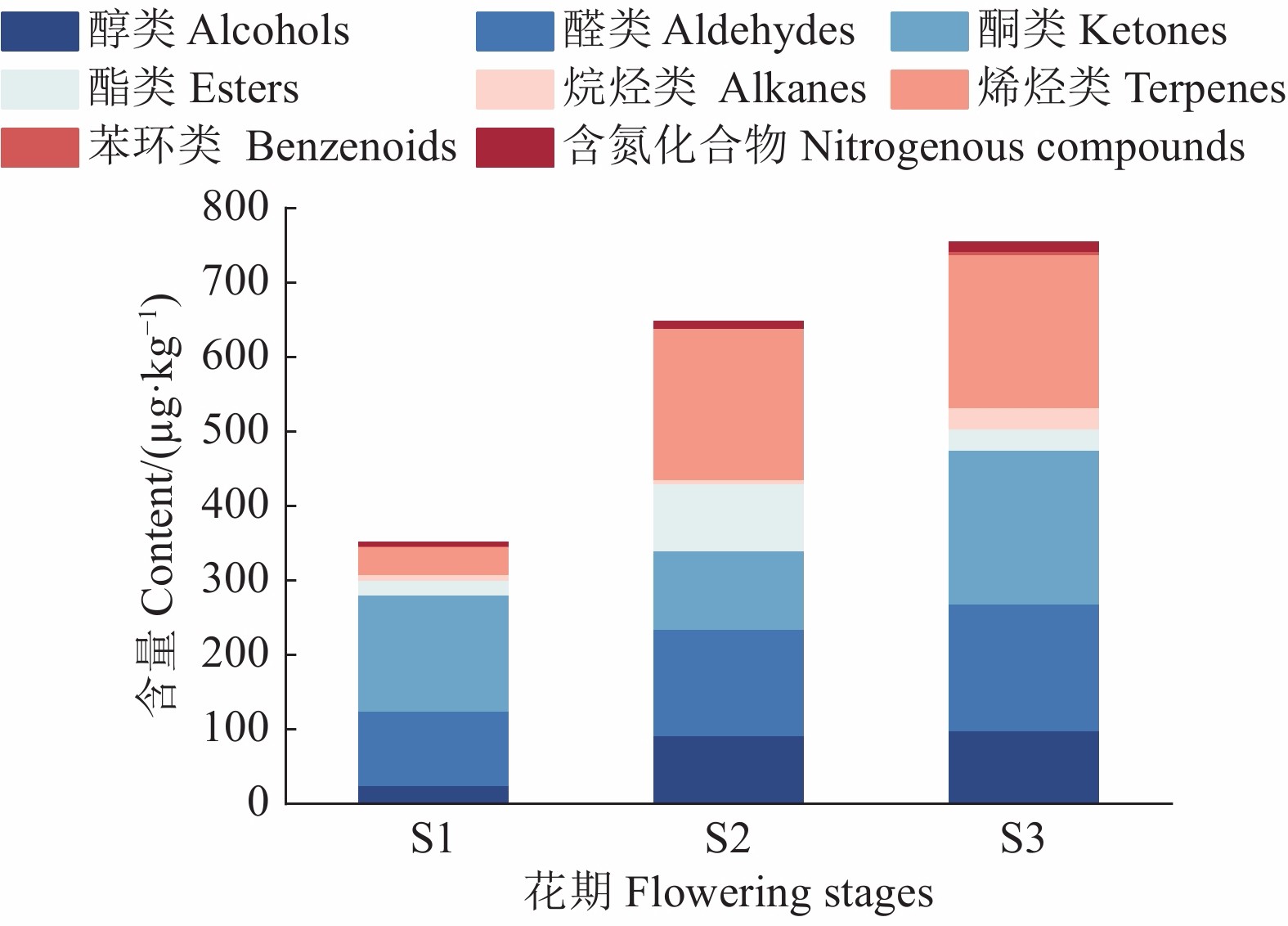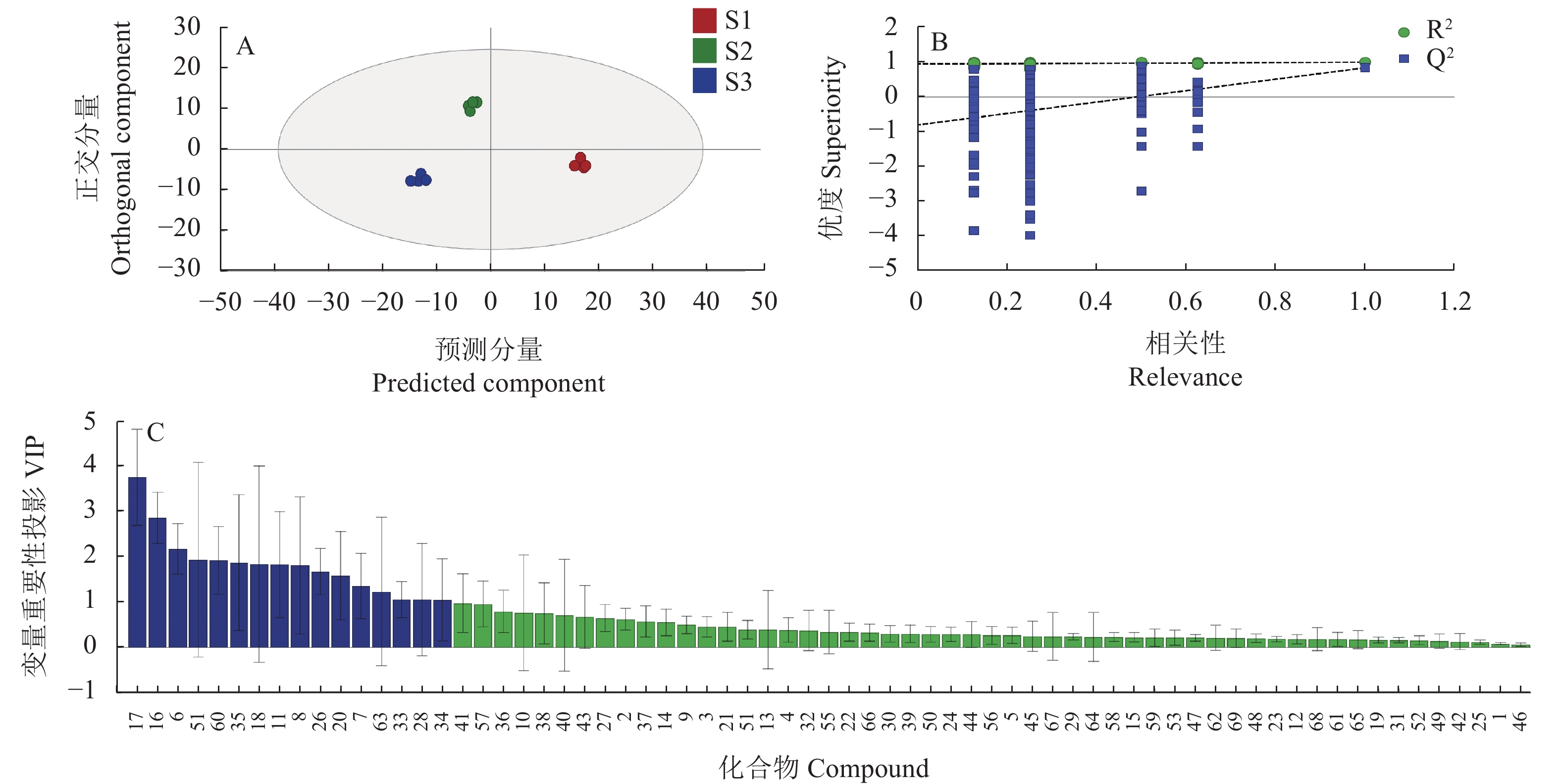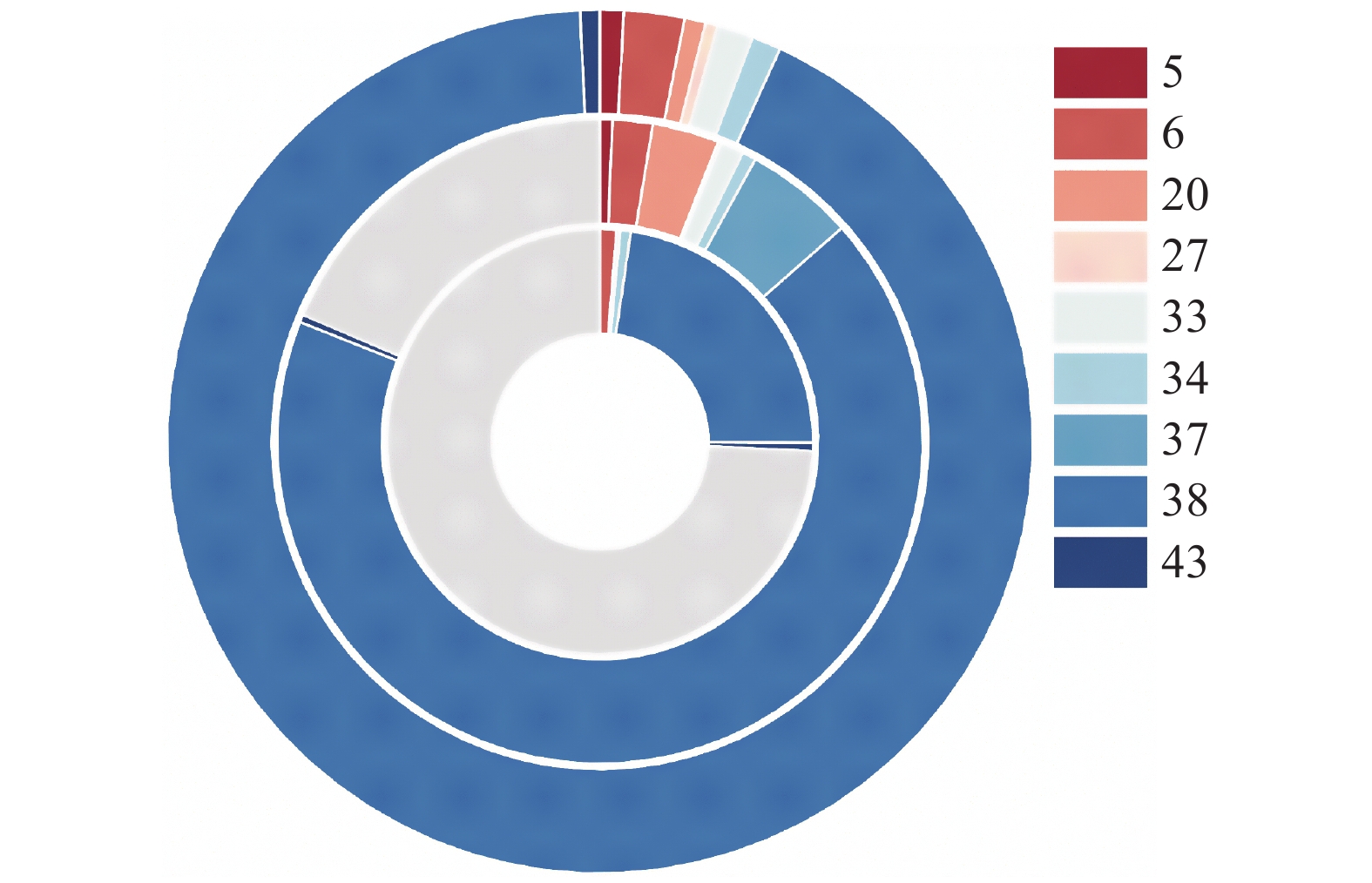GC-MS Analysis on Volatiles of Iris lactea var. chinensis at Different Flowering Stages
-
摘要:
目的 检测马蔺[Iris lactea var. chinensis(Fisch.) Koidz.]不同花期的挥发性成分,探索其挥发性成分的释放规律,为花香机理研究和育种工作提供理论依据。 方法 以花蕾期、盛花期、衰败期的马蔺花朵为材料,采用顶空固相微萃取结合气相色谱-质谱联用(HS-SPME-GC-MS)分析其挥发性成分。 结果 3个时期共检测出69种化合物,挥发性成分总释放量呈递增趋势,物质种类以酮类、烯烃类、醛类为主,其次为醇类、酯类,而烷烃类、苯环类、含氮化合物含量较少。花蕾期的主要成分是己醛、环己酮、甲基庚烯酮、β-鸢尾酮,盛花期的主要成分是己醛、(−)-β-蒎烯、甲基庚烯酮,衰败期的主要成分是(−)-β-蒎烯、甲基庚烯酮、己醛、苯乙醇、环己酮。正交偏最小二乘判别分析表明3-甲基庚烷、甲基庚烯酮、(−)-β-蒎烯、正己酸乙酯、2-蒎烯、3-蒈烯、芳樟醇、苯乙醇、癸酸乙酯、β-鸢尾酮是马蔺不同花期的差异挥发性成分。香气活力值(Odor activity value,OAV)表明:2-甲氧基-3-仲丁基吡嗪、正己酸乙酯、芳樟醇、壬醛、己醛、反式-2-壬烯醛是马蔺的特征香气成分,其中2-甲氧基-3-仲丁基吡嗪的OAV极显著大于其他化合物(P<0.01),是马蔺的主要呈香物质。 结论 马蔺不同花期的挥发性成分差异明显,衰败期是香气最强的时期,己醛、甲基庚烯酮、环己酮、苯乙醇是马蔺的主要挥发性成分。 Abstract:Objective Floral fragrance and release of Iris at different stages were analyzed using GC-MS. Methods Volatiles in the flowers of Iris lactea var. chinensis (Fisch.) Koidz at budding, blooming, and fading stages were determined by HS-SPME-GC-MS. Result The analysis identified 69 distinct aromatics. The continuously released volatiles in the entire flowering period were mainly ketones, terpenes, and aldehydes. There were also alcohols, esters, as well as in smaller quantities of alkanes, benzenoids, and nitrogenous compounds. At different flowering stages, hexanal, cyclohexanone, 5-hepten-2-one, 6-methyl- and β−irone were detected in the buds, hexanal, (−)-β−pinene, and 5-hepten-2-one, 6-methyl- in the blooms, and (-)-β−pinene, 5-hepten-2-one, 6-methyl-, hexanal, phenylethyl alcohol, and cyclohexanone in the fading flowers. The OPLS-DA showed differentiations on heptane, 3-methyl-, 5-hepten-2-one, 6-methyl-, (−)-β−pinene, hexanoic acid, ethyl ester, α−pinene, 3-carene, linalool, phenethyl alcohol, decanoic acid, ethyl ester, and β−irone at these stages. The calculated odor activity values (OAVs) on pyrazine, 2-methoxy-3-(1-methylpropyl)-, hexanoic acid, ethyl ester, linalool, nonanal, hexanal, 2-nonenal, and (E)- indicated that these were the characteristic aromatic substances of I. lactea var. chinensis and that pyrazine and 2-methoxy-3-(1-methylpropyl)- significantly greater in quantity (P<0.01). Conclusion For the first time, the chemical composition of the fragrance of I. lactea var. chinensis flowers was analyzed, and compounds identified in detail. The released volatiles differed significantly during the floral development. It was at the fading stage when the fragrance peaked with the major aromatic contributors including hexanal, 5-hepten-2-one, 6-methyl-, cyclohexanone, and phenethyl alcohol. -
Key words:
- Iris lactea var. chinensis (Fisch.) Koidz /
- flowering period /
- volatiles /
- GC-MS
-
表 1 马蔺不同花期的挥发性成分和含量
Table 1. Aromatics in I. lactea var. chinensis at flowering stages
编号
Code保留时间
Retention time/min化合物
Compound含量 Content/(µg·kg−1) 花蕾期 S1 盛花期 S2 衰败期 S3 1 4.18 2,3-二甲基戊烷 Pentane, 2,3-dimethyl- — — 0.06±0.02 2 4.26 环戊酮 Cyclopentanone 5.24±2.15 a 1.49±0.19 b — 3 4.46 2,5-二甲基己烷 Hexane, 2,5-dimethyl- — — 1.91±1.52 4 4.56 1-戊醇1-Pentanol 0.68±0.26 a 2.05±0.81 a 2.52±1.84 a 5 4.71 2-甲基丁酸甲酯 Butanoic acid, 2-methyl-, methyl ester — 0.69±0.15 a 0.99±1.11 a 6 5.43 己醛 Hexanal 69.55±40.44 a 113.68±37.47 a 127.41±41.84 a 7 5.89 3-甲基庚烷 Heptane, 3-methyl- 1.56±1.41 b 2.77±3.71 b 19.59±13.82 a 8 7.02 环己酮 Cyclohexanone 56.82±17.18 a 44.19±28.95 a 71.79±37.74 a 9 7.29 壬烷 Nonane — — 2.25±1.32 10 7.43 环己醇 Cyclohexanol — 6.17±8.64 a 1.36±1.83 a 11 7.53 正己醇 1-Hexanol 3.54±1.50 a 34.05±30.59 a 16.32±27.58 a 12 8.18 1,2-二甲苯 1,2-Xylene 0.09±0.07 b — 0.30±0.29 a 13 8.52 庚醛 Heptanal 0.75±0.23 a 0.95±0.29 a 2.57±3.84 a 14 10.35 环己烷基甲醛 Cyclohexanecarboxaldehyde 1.52±1.78 a 2.81±1.47 a — 15 10.46 间乙基甲苯 Benzene, 1-ethyl-3-methyl- — — 0.47±0.33 16 11.24 甲基庚烯酮 5-Hepten-2-one, 6-methyl- 53.19±6.64 b 59.20±26.86 b 128.76±35.71 a 17 11.39 (−)-β-蒎烯 (−)-β-Pinene — 142.38±102.90 a 168.58±108.20 a 18 11.41 月桂烯 β-Myrcene 22.40±15.64 a 30.70±40.27 a — 19 11.5 均三甲苯 Mesitylene 0.12±0.07 b — 0.21±0.12 a 20 11.7 正己酸乙酯 Hexanoic acid, ethyl ester — 20.62±11.13 a 4.86±6.50 b 21 11.74 癸烷 Decane 0.74±0.27 a — 2.08±1.53 a 22 11.85 正辛醛 Octanal 2.56±2.31 a 2.04±0.64 a 2.61±1.47 a 23 12.54 4-异丙基甲苯 p-Cymene — — 0.30±0.03 24 12.69 2-乙基己醇 1-Hexanol, 2-ethyl- 0.57±0.54 a — 0.60±0.22 a 25 12.72 桉叶油醇 Eucalyptol 0.15±0.01 — — 26 12.94 2-蒎烯 α-Pinene — 28.27±15.30 a 35.96±20.04 a 27 13.17 苯乙醛 Benzeneacetaldehyde — 1.86±0.12 b 5.05±1.26 a 28 13.21 3-蒈烯 3-Carene 14.70±12.33 — — 29 13.55 萜品烯 γ-Terpinene — 0.65±0.16 a 0.56±0.56 a 30 14.01 顺-α,α-5-三甲基-5-乙烯基四氢化呋喃-2-甲醇 Linalool oxide — — 0.85±0.39 31 14.07 1-辛醇 1-Octanol 0.28±0.06 — — 32 14.31 对二乙苯 Benzene, 1,4-diethyl- — — 1.57±1.89 33 14.92 芳樟醇 Linalool 3.82±1.78 b 15.28±3.95 a 17.86±10.53 a 34 15.06 壬醛 Nonanal 17.90±12.85 a 15.71±4.51 a 24.60±14.64 a 35 15.33 苯乙醇 Phenethyl alcohol 15.28±5.04 b 32.67±23.32 ab 58.63±41.87 a 36 15.86 邻甲基苯乙酮 Ethanone, 1-(2-methylphenyl)- — — 5.51±5.45 37 16.77 反式-2-壬烯醛 2-Nonenal, (E)- — 2.31±0.98 — 38 16.89 2-甲氧基-3-仲丁基吡嗪 Pyrazine, 2-methoxy-3-(1-methylpropyl)- 2.56±1.26 a 7.59±2.69 a 10.39±9.60 a 39 17.15 1-壬醇 1-Nonanol 0.24±0.22 b 0.69±0.41 a — 40 17.76 水杨酸甲酯 Methyl salicylate 7.33±10.37 — — 41 17.81 辛酸乙酯 Octanoic acid, ethyl ester 1.46±1.54 b 8.78±5.83 a 2.50±1.74 b 42 17.93 十二烷 Dodecane 0.75±0.04 a 0.63±0.29 a 0.79±0.17 a 43 18.11 癸醛 Decanal 6.40±3.72 a 3.87±0.67 a 7.42±6.12 a 44 18.47 β-环柠檬醛 β-Cyclocitral 0.43±0.41 ab 0.10±0.08 b 1.10±0.95 a 45 19.28 1,3-二叔丁基苯 Benzene, 1,3-bis(1,1-dimethylethyl)- 1.31±1.63 a 0.80±0.88 a 1.65±1.72 a 46 20.14 (+)-异薄荷醇 (1S,2R,5R)-(+)-Isomenthol 0.05±0.04 — — 47 20.6 甲基壬基甲酮2-Undecanone — — 0.38±0.05 48 20.63 壬酸乙酯 Nonanoic acid, ethyl ester — 0.26±0.04 — 49 20.98 十一醛 Undecanal 0.25±0.28 — — 50 21.39 癸酸甲酯 Decanoic acid, methyl ester 1.02±0.49 a 0.88±0.66 a — 51 23.28 癸酸乙酯 Decanoic acid, ethyl ester 5.07±5.04 a 31.26±28.24 a 4.49±2.95 a 52 23.43 十四烷 Tetradecane 0.42±0.26 a 0.67±0.13 a 0.69±0.28 a 53 23.69 月桂醛 Dodecanal 0.57±0.50 a — 0.06±0.02 b 54 24.51 异丁酸苯乙酯 Benzylcarbinol isobutyrate — — 1.46±1.21 55 24.63 香叶基丙酮 Geranyl acetone 1.55±2.32 — — 56 24.76 石竹烯 Caryophyllene — 0.48±0.26 — 57 25.67 异戊酸苯乙酯 β-Phenylethyl isovalerate 1.13±1.08 a 12.25±3.92 a 10.76±13.15 a 58 25.79 2-十三烷酮 2-Tridecanone — 0.54±0.18 a 0.38±0.00 b 59 25.88 正十五烷 Pentadecane 0.93±0.95 a 0.29±0.15 b 0.32±0.12 b 60 26 β-鸢尾酮 β-Irone 38.42±10.40 — — 61 26.12 十三醛 Tridecanal 0.32±0.29 a 0.39±0.45 a — 62 26.37 月桂酸甲酯 Dodecanoic acid, methyl ester 1.19±0.53 a 0.74±0.10 ab 0.50±0.33 b 63 27.64 月桂酸乙酯 Dodecanoic acid, ethyl ester 3.21±1.46 a 13.55±12.97 a 2.17±2.34 a 64 27.76 正十六烷 Hexadecane 1.59±2.09 a 0.66±0.11 a 0.78±0.20 a 65 27.98 肉豆蔻醛 Tetradecanal 0.47±0.45 a 0.17±0.10 a — 66 28.87 豆蔻醇 1-Tetradecanol — 0.66±0.19 — 67 29.28 正十七烷 Heptadecane 1.40±1.96 a 0.43±0.04 a 0.62±0.29 a 68 30.49 十四酸乙酯 Tetradecanoic acid, ethyl ester 0.28±0.22 a 0.49±0.54 a 0.15±0.08 a 69 32.83 十六酸乙酯 Hexadecanoic acid, ethyl ester — 0.40±0.34 a 0.21±0.02 a 根据保留时间对物质进行编号“1~69”。“—”表示未鉴定出,同一行中不同的小写字母表示在0.05水平上差异显著。
1-69: codes for compounds exited at different analytical retention time. "—" indicates not identified. Data with different lowercase letters on same line indicate significant difference at 0.05 level. -
[1] 陈秀中, 王琪. 中华民族传统赏花理论探微 [J]. 北京林业大学学报, 2001, 23(S1):16−21.CHEN X Z, WANG Q. Studies on Chinese principles in appreciating traditional flowers [J]. Journal of Beijing Forestry University, 2001, 23(S1): 16−21.(in Chinese) [2] PICHERSKY E, GERSHENZON J. The formation and function of plant volatiles: Perfumes for pollinator attraction and defense [J]. Current Opinion in Plant Biology, 2002, 5(3): 237−243. doi: 10.1016/S1369-5266(02)00251-0 [3] 许玉凤, 史国旭, 金罡, 等. 鸢尾属植物马蔺(Iris lactea Pall. var. chinensis)的研究进展 [J]. 种子, 2011, 30(4):67−70. doi: 10.3969/j.issn.1001-4705.2011.04.018XU Y F, SHI G X, JIN G, et al. Recent progresses in the research of iris lactea pall. var. chinensis [J]. Seed, 2011, 30(4): 67−70.(in Chinese) doi: 10.3969/j.issn.1001-4705.2011.04.018 [4] 刘玉艳, 赵会芝, 伍敏华, 等. 干旱胁迫下马蔺与高羊茅的生理反应比较 [J]. 河北农业大学学报, 2008, 31(4):41−46. doi: 10.3969/j.issn.1000-1573.2008.04.008LIU Y Y, ZHAO H Z, WU M H, et al. Physiological responses of Iris lactea var. chinensis and Festuca arundinaces to drought stress [J]. Journal of Agricultural University of Hebei, 2008, 31(4): 41−46.(in Chinese) doi: 10.3969/j.issn.1000-1573.2008.04.008 [5] 袁泽斌. 马蔺对混合盐胁迫的响应及盐碱土改良效果的研究[D]. 苏州: 苏州大学, 2020YUAN Z B. Study on the response of iris lactea var. chinensis to mixed saline stress and the improvement effect of saline-alkali soil[D]. Suzhou: Soochow University, 2020. (in Chinese) [6] GOODRICH K R, RAGUSO R A. The olfactory component of floral display in Asimina and Deeringothamnus (Annonaceae) [J]. The New Phytologist, 2009, 183(2): 457−469. doi: 10.1111/j.1469-8137.2009.02868.x [7] ASCRIZZI R, FLAMINI G. Iris lutescens on serpentine soil: Volatile emission profiles in different organs of its two colour morphs [J]. Plant Biosystems - an International Journal Dealing With All Aspects of Plant Biology, 2021, 155(2): 406−414. doi: 10.1080/11263504.2020.1756973 [8] WANG H, CONCHOU L, BESSIÈRE J M, et al. Flower color polymorphism in Iris lutescens (Iridaceae): Biochemical analyses in light of plant-insect interactions [J]. Phytochemistry, 2013, 94: 123−134. doi: 10.1016/j.phytochem.2013.05.007 [9] YUAN Y, SUN Y, ZHAO Y C, et al. Identification of floral scent profiles in bearded irises [J]. Molecules, 2019, 24(9): 1773. doi: 10.3390/molecules24091773 [10] ZITO P, ROSSELLI S, BRUNO M, et al. Floral scent in Iris planifolia (Iridaceae) suggests food reward [J]. Phytochemistry, 2019, 158: 86−90. doi: 10.1016/j.phytochem.2018.11.011 [11] 孔兰, 樊荣辉, 林榕燕, 等. 杂交兰花色花香生物合成途径的转录组分析 [J]. 西北植物学报, 2021, 41(1):86−95.KONG L, FAN R H, LIN R Y, et al. Transcriptome analysis of pigment biosynthesis and floral scent biosynthesis in Cymbidium hybrid [J]. Acta Botanica Boreali-Occidentalia Sinica, 2021, 41(1): 86−95.(in Chinese) [12] 程玉芬, 张志伟, 贾永霞, 等. 对叶榕花序不同发育时期气味成分的变化及其对传粉者的吸引作用 [J]. 热带亚热带植物学报, 2019, 27(3):299−308. doi: 10.11926/jtsb.4016CHENG Y F, ZHANG Z W, JIA Y X, et al. Odour composition variation at different stages of Ficus hispida inflorescence and the attraction to pollinators [J]. Journal of Tropical and Subtropical Botany, 2019, 27(3): 299−308.(in Chinese) doi: 10.11926/jtsb.4016 [13] 徐鑫鑫, 秦民坚. 马蔺根的化学成分研究 [J]. 药学与临床研究, 2010, 18(3):260−261,264.XU X X, QIN M J. Chemical constituents in the roots of iris lactea Pall. var. Chinensis [J]. Pharmaceutical and Clinical Research, 2010, 18(3): 260−261,264.(in Chinese) [14] YUN J, CUI C J, ZHANG S H, et al. Use of headspace GC/MS combined with chemometric analysis to identify the geographic origins of black tea [J]. Food Chemistry, 2021, 360: 130033. doi: 10.1016/j.foodchem.2021.130033 [15] VAN GEMERT L J. Compilations of odour threshold values in air, water and other media[M]. Boelens Aroma Chemical Information Service, 2003. [16] 李程勋, 李爱萍, 徐晓俞, 等. 百香果果皮精油提取及香气成分分析 [J]. 福建农业学报, 2019, 34(4):495−501.LI C X, LI A P, XU X Y, et al. Extraction and aromatics of essential oil from passion fruit peels [J]. Fujian Journal of Agricultural Sciences, 2019, 34(4): 495−501.(in Chinese) [17] 周晨晨, 范俊俊, 谭瑞楠, 等. ‘白兰地’海棠不同花期与不同花器官的香气成分分析 [J]. 福建农业学报, 2022, 37(8):1038−1047.ZHOU C C, FAN J J, TAN R N, et al. Aromatics in floral organs of Malus Brandywine during different flowering stages [J]. Fujian Journal of Agricultural Sciences, 2022, 37(8): 1038−1047.(in Chinese) [18] 范俊俊. 观赏海棠花朵香型分析与判别模型构建[D]. 南京: 南京林业大学, 2019.FAN J J. Analysis and discrimination model construction of flower scent intensity type for flowering crabapple[D]. Nanjing: Nanjing Forestry University, 2019. (in Chinese) [19] 肖文芳, 李佐, 陈和明, 等. 基于HS-SPME-GC-MS的4种不同蝴蝶兰种质资源花朵挥发性成分比较分析 [J]. 中国农业大学学报, 2021, 26(3):38−52.XIAO W F, LI Z, CHEN H M, et al. Analysis of volatile components in flowers of four different Phalaenopsis germplasm resources by headspace solid phase microextraction coupled with gas chromatography-mass spectrometry [J]. Journal of China Agricultural University, 2021, 26(3): 38−52.(in Chinese) [20] 强文彦, 孟庆然, 张志国, 等. 萱草不同品种花瓣挥发性物质的HS-SPME-GC-MS分析 [J]. 园艺学报, 2023, 50(1):116−130.QIANG W Y, MENG Q R, ZHANG Z G, et al. Analysis of petal volatile components among different Hemerocallis cultivars based on HS-SPME-GC-MS [J]. Acta Horticulturae Sinica, 2023, 50(1): 116−130.(in Chinese) [21] 周小理, 朱思怡, 周一鸣, 等. 不同萱草杂交品种花部风味物质分析[J/OL]. 分子植物育种: 1−12. [2023-03-12]. http://kns.cnki.net/kcms/detail/46.1068.S.20221015.1117.004.html.ZHOU X L, ZHU S Y, ZHOU Y M, et al. Analysis of flavor substances in flowers of different hybrids of hemerocallis [J]. Molecular Plant Breeding: 1−12. [2023-03-12]. http://kns.cnki.net/kcms/detail/46.1068.S.20221015.1117.004.html (in Chinese) [22] KNUDSEN J T, ERIKSSON R, GERSHENZON J, et al. Diversity and distribution of floral scent [J]. The Botanical Review, 2006, 72(1): 1. doi: 10.1663/0006-8101(2006)72[1:DADOFS]2.0.CO;2 [23] 徐瑾, 李莹莹, 郑成淑, 等. 菊花不同花期及花序不同部位香气成分和挥发研究 [J]. 西北植物学报, 2012, 32(4):722−730.XU J, LI Y Y, ZHENG C S, et al. Studies of aroma compounds in Chrysanthemum in different florescence and inflorescence parts and aroma releasing [J]. Acta Botanica Boreali-Occidentalia Sinica, 2012, 32(4): 722−730.(in Chinese) [24] 邹晶晶, 蔡璇, 曾祥玲, 等. 桂花不同品种开花过程中香气活性物质的变化 [J]. 园艺学报, 2017, 44(8):1517−1534.ZOU J J, CAI X, ZENG X L, et al. Changes of aroma-active compounds in different cultivars of Osmanthus fragrans during flowering [J]. Acta Horticulturae Sinica, 2017, 44(8): 1517−1534.(in Chinese) [25] 辛晓栋, 温欣宇, 降佳君, 等. 基于非靶向代谢组学的槟榔花香关键代谢物的筛选[J]. 热带作物学报, 2023,44(7):1328−1336.XIN X D, WEN X Y, XIE J J, et al. Screening of key metabolites of areca flower fragrance based on non-targeted metabonomics [J]. Chinese Journal of Tropical Crops, 2023,44(7):1328−1336. (in Chinese) [26] WOO J, YANG H, YOON M, et al. 3-carene, a phytoncide from pine tree has a sleep-enhancing effect by targeting the GABAA-benzodiazepine receptors [J]. Experimental Neurobiology, 2019, 28(5): 593−601. doi: 10.5607/en.2019.28.5.593 [27] SCHIESTL F P. The evolution of floral scent and insect chemical communication [J]. Ecology Letters, 2010, 13(5): 643−656. doi: 10.1111/j.1461-0248.2010.01451.x [28] LILLEY B D, BREWER J H. The selective antibacterial action of phenylethyl alcohol [J]. Journal of the American Pharmaceutical Association (Scientific edition), 1953, 42(1): 6−8. doi: 10.1002/jps.3030420103 [29] ROSS G N, FALES H M, LLOYD H A, et al. Novel chemistry of abdominal defensive glands of nymphalid butterfly Agraulis vanillae [J]. Journal of Chemical Ecology, 2001, 27(6): 1219−1228. doi: 10.1023/A:1010372114144 [30] ZERINGÓTA V, PEREIRA-JUNIOR R A, SARRIA A L F, et al. Identification of a non-host semiochemical from miniature pinscher, Canis lupus familiaris, that repels Rhipicephalus sanguineus sensu lato (Acari: Ixodidae) [J]. Ticks and Tick-Borne Diseases, 2021, 12(1): 101582. doi: 10.1016/j.ttbdis.2020.101582 [31] CARDOZA Y J, ALBORN H T, TUMLINSON J H. In vivo volatile emissions from peanut plants induced by simultaneous fungal infection and insect damage [J]. Journal of Chemical Ecology, 2002, 28(1): 161−174. doi: 10.1023/A:1013523104853 [32] VENCL F V, OTTENS K, DIXON M M, et al. Pyrazine emission by a tropical firefly: An example of chemical aposematism? [J]. Biotropica, 2016, 48(5): 645−655. doi: 10.1111/btp.12336 -








 下载:
下载:



